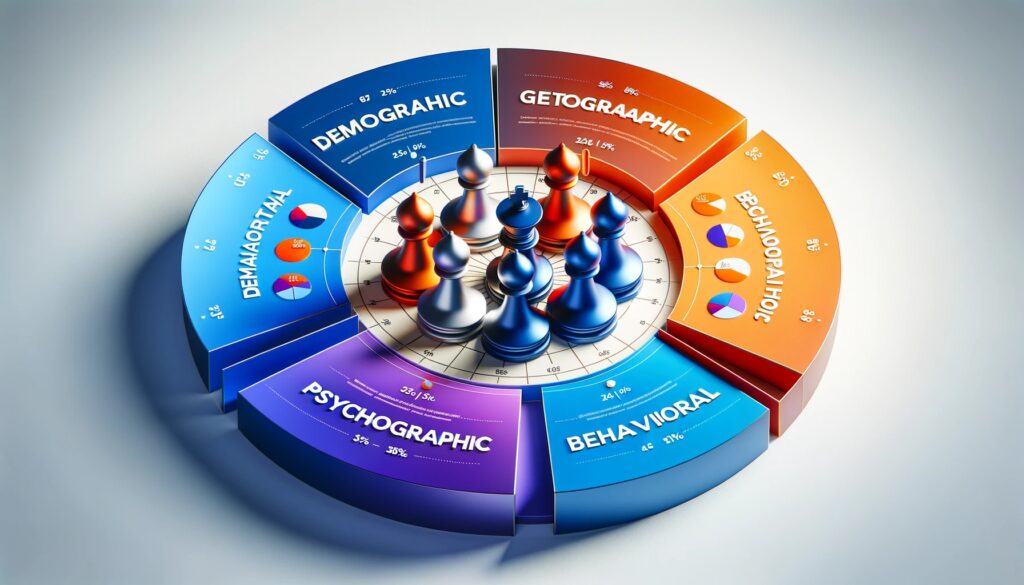
Understanding customer behavior is crucial for successful advertising. Behavioral segmentation, powered by artificial intelligence, helps businesses deliver personalized and engaging experiences.
What is Behavioral Segmentation in Advertising?
Understanding the Basics
Behavioral segmentation divides customers into groups based on actions like purchase history, browsing patterns, or engagement levels. It’s about tailoring messages to specific behaviors, not just demographics.
AI takes this further by analyzing vast data sets and spotting patterns that human marketers might miss. This data-driven approach enables hyper-personalized campaigns, significantly boosting ROI.
Why Behavior Matters More Than Demographics
While age or location matters, they don’t tell the full story. A 25-year-old and a 55-year-old could exhibit the same buying behavior online. Behavioral data provides actionable insights, ensuring every ad is relevant to its audience.
By focusing on behavior, businesses can predict needs, resolve pain points, and foster brand loyalty.
How AI Transforms Behavioral Segmentation
Advanced Data Collection and Processing
AI gathers and processes data from multiple sources, including websites, apps, social media, and email.
- AI tools analyze real-time user behavior, like clicks and page views.
- Predictive models forecast future actions, enabling proactive marketing strategies.
For example, AI can identify when customers are most likely to repurchase and send reminders at the perfect moment.
Dynamic Segmentation for Evolving Audiences
With traditional methods, segments remain static. AI introduces dynamic segmentation, where groups evolve based on new data.
This adaptability ensures campaigns always reflect current customer interests, keeping your brand relevant in a competitive market.
Benefits of AI-Driven Behavioral Segmentation
Unmatched Personalization
AI crafts tailored messages for each segment. Imagine showing a lapsed customer a personalized discount versus recommending complementary products to a recent buyer.
Personalized ads are not just effective—they build trust. And trust leads to long-term customer relationships.
Higher Efficiency and Cost Savings
Manual segmentation is time-consuming. AI automates the process, freeing up valuable resources for creativity and strategy.
By targeting only high-intent customers, businesses cut down on wasted ad spend and boost overall efficiency.
Key AI Tools for Behavioral Segmentation
Popular Platforms Driving Change
Several tools help businesses incorporate AI into behavioral segmentation, such as:
- Google Analytics 4 for real-time insights into user journeys.
- Salesforce Marketing Cloud for advanced customer segmentation and automation.
- HubSpot for actionable data on consumer engagement.
Each platform integrates seamlessly with ad systems, streamlining marketing efforts while delivering measurable results.
Emerging Technologies in AI
From machine learning algorithms to natural language processing, emerging AI tech is making segmentation smarter. These innovations let businesses analyze customer sentiment and adjust strategies in seconds.

Applications of Behavioral Segmentation in Advertising
Optimizing Campaign Targeting
Behavioral segmentation ensures ads reach the right audience at the right time. Instead of broadcasting a single message, brands can send tailored content.
- Retargeting ads: Show reminders to users who abandoned carts.
- Upselling campaigns: Suggest premium upgrades to customers showing purchase interest.
- Event-based marketing: Offer discounts on customers’ birthdays or anniversaries.
These tailored approaches improve engagement and conversion rates, making every ad dollar count.
Cross-Channel Personalization
AI-powered behavioral segmentation works seamlessly across platforms. From social media to email marketing, it creates consistent, personalized experiences:
- Social Media Ads: AI helps analyze interaction patterns to optimize ad timing and format.
- Email Campaigns: Behavioral triggers like purchase history drive relevant, click-worthy email content.
Customers experience a cohesive journey, building trust and loyalty.
Case Studies: Behavioral Segmentation in Action

Amazon’s Personalized Recommendations
Amazon uses AI to analyze browsing and purchase behaviors, creating personalized shopping suggestions. This segmentation increases average cart value while improving customer satisfaction.
Imagine searching for fitness gear and immediately seeing complementary items like protein shakes or yoga mats. These tailored prompts drive impulse purchases.
Spotify’s Listening Habits Insights
Spotify tracks user listening behaviors to build customized playlists and suggest new songs. Their “Discover Weekly” playlist is a hit because it feels uniquely tailored.
This strategy keeps users engaged and encourages them to stay on the platform longer.
Challenges in AI-Driven Behavioral Segmentation
Data Privacy Concerns
Customers are increasingly wary of how their data is collected and used. Companies must prioritize transparency and adhere to data protection laws like GDPR or CCPA.
Building trust means openly communicating what data is collected, why, and how it enhances their experience. Offering easy opt-outs is crucial.
Overpersonalization Risks
While personalization improves engagement, overdoing it can feel invasive. Imagine being greeted by an ad for an item you only considered briefly.
Finding the sweet spot between relevance and intrusion is essential for maintaining customer comfort.
How to Implement AI-Powered Behavioral Segmentation
Step 1: Define Clear Goals
Start with a clear objective. Are you aiming to improve customer retention, boost sales, or enhance engagement?
Without specific goals, it’s challenging to measure the success of segmentation efforts. For example:
- If the goal is retention, focus on identifying churn behaviors.
- For boosting sales, prioritize purchase patterns and upsell opportunities.
Clearly defined goals ensure your segmentation strategy aligns with broader business objectives.
Step 2: Collect and Organize Behavioral Data
Gather data from multiple sources, ensuring it’s clean, organized, and actionable:
- Web activity: Monitor pages viewed, time spent, and cart actions.
- Purchase behavior: Track frequency, amount spent, and product types.
- Social interactions: Analyze likes, shares, and comments.
Modern AI tools like Segment or Mixpanel make this process seamless by integrating data across platforms.
Step 3: Choose the Right AI Tools
AI platforms vary in features. Choose one that aligns with your business needs:
- For real-time segmentation, opt for tools like Adobe Sensei.
- For customer journey mapping, consider Marketo Engage.
Test platforms with trial versions to ensure compatibility and scalability.

Measuring the Success of Behavioral Segmentation
Key Performance Indicators (KPIs)
Track these metrics to evaluate success:
- Click-Through Rates (CTR): Measure engagement with personalized ads.
- Conversion Rates: Determine how well tailored campaigns drive sales.
- Customer Lifetime Value (CLV): Analyze the long-term revenue potential of segmented groups.
Consistently monitor and adjust campaigns based on these insights to maximize effectiveness.
Customer Feedback and Insights
Beyond numbers, ask customers about their experiences. Surveys and reviews provide qualitative insights into how segmentation strategies are perceived.
For example, if a majority praises the relevance of your ads, your segmentation approach is working well.
Benefits and Challenges of AI-Driven Behavioral Segmentation
The Bright Side: Precision and Personalization
AI enhances precision by identifying micro-segments, ensuring campaigns are not just personalized but deeply relevant.
- Example: A fitness brand targets users who buy running gear but not supplements, offering bundle discounts to fill that gap.
Navigating the Risks
- Overpersonalization: Repeatedly showing ads for a product someone glanced at can feel invasive.
- Data Privacy: With increasing regulations like GDPR, businesses must prioritize transparency and consent.
By respecting boundaries and focusing on value, brands can balance personalization with privacy.
Emerging Trends in Behavioral Segmentation
Voice and Visual Data Segmentation
As AI evolves, voice searches and visual preferences are unlocking new dimensions in behavioral segmentation:
- Voice data: Virtual assistants like Alexa analyze commands to refine preferences.
- Visual data: Pinterest analyzes pins and boards to predict user tastes.
Brands integrating these insights can deliver next-level personalization.
AI-Driven Sentiment Analysis
Combining behavioral data with sentiment analysis allows businesses to gauge emotional responses to their messaging.
- Example: A beauty brand might analyze social media mentions to understand customer sentiment around a new product launch, refining its next campaign based on feedback.
Conclusion: The Power of AI in Understanding Customers
AI-driven behavioral segmentation isn’t just a trend—it’s the future of advertising. By analyzing behaviors, predicting preferences, and crafting personalized campaigns, brands can connect with audiences like never before.
The key is balance: respecting customer privacy while delivering meaningful, relevant experiences. With the right tools and strategies, behavioral segmentation can transform your marketing game and build lasting customer relationships.
Start decoding preferences today and watch your advertising impact soar!
Let me know if you’d like further tips or links to tools and guides.
FAQs
What types of behaviors can be segmented?
Brands can segment based on:
- Purchase frequency: Loyal buyers vs. occasional shoppers.
- Engagement level: Active app users vs. dormant accounts.
- Browsing patterns: Users researching a product but not purchasing.
Imagine a coffee shop app tracking users who order lattes regularly. They could offer promotions to encourage trying other menu items, like seasonal drinks.
How can small businesses leverage AI-driven behavioral segmentation?
Small businesses can use affordable AI tools like HubSpot or Zoho CRM to analyze customer behaviors without needing extensive resources.
For example, a boutique could track which customers browse specific categories, such as jewelry or handbags, and send personalized offers for those items.
What are the risks of behavioral segmentation?
Risks include overpersonalization, which may feel invasive, and data privacy concerns. To mitigate these risks:
- Avoid being overly specific in messaging.
- Adhere to laws like GDPR by obtaining customer consent for data use.
For instance, instead of directly referencing an abandoned cart item in an email, suggest similar products to make the interaction feel less intrusive.
How does behavioral segmentation enhance customer retention?
By understanding behaviors like purchase history and engagement, businesses can create personalized experiences that keep customers coming back.
For example, a fitness app notices a user frequently tracks workouts but hasn’t upgraded to premium. A tailored message offering a trial of advanced features can re-engage and encourage long-term subscription.
What industries benefit most from AI-driven behavioral segmentation?
Any industry with customer interaction can benefit, but it’s particularly impactful in:
- E-commerce: Personalized product recommendations.
- Hospitality: Targeting travelers based on booking history.
- Healthcare: Sending reminders for medications or appointments.
For instance, a hotel chain might use AI to target past guests with promotions for their favorite destinations during holidays.
Can behavioral segmentation work across multiple channels?
Yes, behavioral segmentation powered by AI ensures consistency across platforms like email, social media, and apps.
For example, if a user browses laptops on a retailer’s website, they might later see ads for laptops on Instagram or receive a personalized email with offers for that product category.
What tools are available for AI-driven behavioral segmentation?
Popular tools include:
- Google Analytics 4: Tracks user journeys and behaviors.
- Segment: Centralizes customer data for actionable insights.
- Klaviyo: Ideal for e-commerce behavioral marketing.
For instance, a clothing store using Klaviyo can analyze purchase data to recommend accessories that complement past orders.
How does behavioral segmentation align with privacy concerns?
Transparency is key. Inform customers about data usage and ensure compliance with privacy laws like GDPR or CCPA. Offer opt-outs and focus on ethical data practices.
For example, an email might include a line like: “We noticed you enjoyed browsing our collection. Let us know if you’d prefer fewer recommendations.” This builds trust while respecting user preferences.
Resources
Articles and Guides
- HubSpot’s Guide to Behavioral Marketing
A comprehensive overview of behavioral marketing strategies, with actionable tips for beginners and pros alike. - Google Analytics 4 Documentation
A step-by-step guide to using Google Analytics for tracking user behaviors and segmenting audiences. - Forbes: How AI Is Transforming Marketing
Insightful article on how AI enhances customer segmentation and personalization across industries.
Tools and Platforms
- Segment: A customer data platform that helps centralize behavioral data for deeper insights. Learn More
- Klaviyo: A powerful tool for creating tailored email and SMS campaigns based on customer behavior. Learn More
- Adobe Sensei: AI technology integrated with Adobe’s marketing suite to automate segmentation and predictive analysis. Learn More





